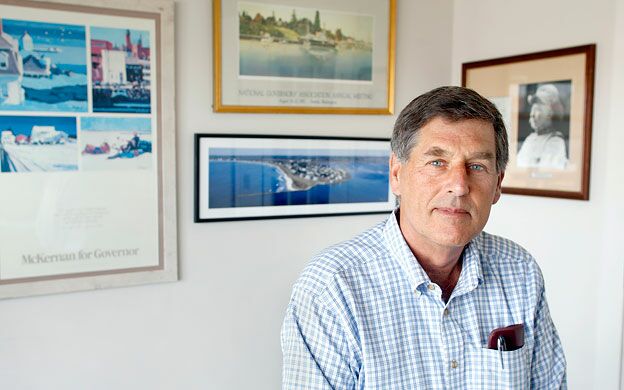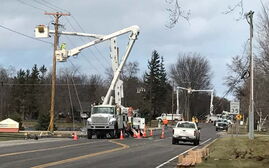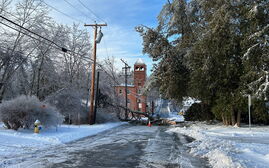Boothbay electricity project aims to change the grid
The hottest hours of the hottest days on the sprawling fingers of the Boothbay peninsula come close to critically straining the area's electricity transmission lines.
One option to avoid a potential blackout is an $18 million upgrade of existing power lines so they can handle that peak demand. But the Maine Public Utilities Commission and the Portland-based energy company GridSolar think capacity can be added for less.
To prove the point, GridSolar is leading a pilot project that flips the conventional transmission solution around: it proposes meeting demand by generating power at the end of the line. In this case, right in Boothbay.
The GridSolar plan uses what's called distributed generation — bringing together a variety of power generation resources like solar power, backup generator units, battery storage and an array of other possible sources, to reduce the amount of power transmitted down the peninsula by Central Maine Power Co. to meet peak demand. In power producer parlance, it's called a non-transmission alternative, or NTA. GridSolar is in the midst of soliciting bids from power generators to create what is in essence its own microgrid.
The Boothbay pilot project is the first of its kind in Maine. If successful, it could expand options for Maine regulators and power providers and, over the long-term, provide electrical service now delivered by traditional electric utilities.
For CMP, the project could offer a lower-cost option to making more than $100 million in infrastructure upgrades to its larger midcoast transmission loop, and another series of upgrades to its Portland loop, a project that has no current cost estimate. An initial study by GridSolar shows distributed generation can be cheaper than transmission upgrades, a factor in the Maine Public Utilities Commission giving the three-year Boothbay pilot project all but its final blessing.
"We expect that this is going to be a less expensive option than the [CMP] midcoast transmission proposal," says PUC Commissioner Mark Vannoy. "At the same time, we have not seen the final contracts or the final economic analysis."
A new analysis, following negotiations between GridSolar and on-the-ground power providers like ReVision Energy and Boothbay Microgrid, is expected within weeks. The parties are working out the contract costs for providing electricity on a per kilowatt basis; the final determination will affect whether the PUC signs off on the entire project.
"Ultimately, it's a pilot project to really look at whether a non-transmission alternative is going to work both from a functional reliability standpoint, but also from a financial standpoint," Vannoy says.
Developing the microgrid
Electricity transmission lines are now built to accommodate an area's peak capacity, a level of consumption that's typically needed for just a small fraction of a year.
That model won't survive forever, says Fortunat Mueller, co-founder of ReVision Energy, one of the bidders hoping to provide distributed generation capacity for the Boothbay pilot project.
"Building infrastructure for the absolute peak load is short-sighted and very costly," Mueller says, noting that transmission improvements around his southern Maine home have had linemen stringing up new cables from aboard a helicopter. "It's very impressive to watch, but knowing that I'm eventually paying the bill doesn't make me super happy about it."
It's the high cost of traditional transmission upgrades that, for the time being, will continue to drive microgrid development, according to Thomas Bourgeois, deputy director of the Pace Energy and Climate Center at Pace Law School.
"In remote areas where it's more economically advantageous to create a small microgrid than build out the transmission systems, that would provide an impetus for doing it," Bourgeois says. "But you could also look at it from the opposite side, in highly congested urban areas, like in Manhattan, where it would cost a lot to dig up the streets and would disrupt business and traffic."
Bourgeois says evidence of microgrids' reliability — such as those that kept New York University and Princeton University online through Hurricane Sandy — is generating political support and momentum. Connecticut Gov. Dannel Malloy has launched a $15 million microgrid investment project and is asking the state to set aside $30 million more over the next two years.
Existing utilities might support such non-transmission alternatives, but only in cases where it's prohibitively expensive to build transmission lines, Bourgeois says. Power companies across the country are largely prohibited from owning generation resources, which means the expansion of microgrids in general could ultimately peel away customers that now rely on energy transmitted from afar.
Bourgeois says transmission utilities' role in microgrid expansion remains "pretty unresolved."
"Do we allow the utility to get into this market? If we don't do so, this does put more generation in private hands and would erode the franchise service territory of those providers," Bourgeois says. "And it's not necessarily a bad thing."
For now, whether Maine regulators and power companies add NTAs to their list of solutions to capacity challenges hinges on the Boothbay project.
"Whether it stays a solution from a utility perspective will be really determined by in some respects the people in Boothbay and the PUC," says CMP spokesman John Carroll. "But if it does, then you're going to see this as something that fits sort of parallel to our business."
Changing the grid
By this summer, GridSolar co-founder Richard Silkman says the company expects to have its contracts settled and have distributed generation resources online in Boothbay, producing energy. In total, the project aims to add 2 megawatts of capacity to the Boothbay peninsula, using a network of generation resources and smarter communication throughout the local grid.
"When CMP says the load is too high, we'll call upon those resources to pull that off the grid," Silkman says.
That time, he expects, will most often come in the summer months, when high heat and direct sun boosts air conditioning use. As a result, he says, solar power will be a key component as the peak generation time — when the sun is out — aligns with peak demand. Permitting for that resource is also simpler.
"Most of these smaller, distributed generation resources don't require permits, so it's an easier process than offshore wind turbines or putting tidal generation in the Sheepscot [River]," Silkman says.
While GridSolar remains in negotiations with potential power providers, there has been some movement toward a local generation network. Two local agreements were made public in February when town officials inked a deal with Boothbay Microgrid LLC to allow the installation of solar panels atop three municipal buildings.
In general, under the microgrid arrangement, CMP will compensate GridSolar and its partners for providing energy that defers the company's need for the $18 million transmission upgrade. The details of those compensation rates are unknown, pending GridSolar's submission of final rate structures to the PUC.
Such a compensation structure is largely untested, but microgrid and renewable energy advocates say compensation for capacity reduction, particularly for renewables, is long overdue.
"If you are reliably providing capacity reductions on the [transmission and distribution] system, it's not being paid for, accounted for or measured but it provides a societal value and an uncompensated value," says Bourgeois, of the Pace Energy and Climate Center.
Bourgeois says that uncompensated value is fueling the center's efforts to create a new market that pays small power producers for providing reliability and capacity benefits grid-wide.
That's something Mueller, at ReVision, also has his eye on.
"Almost every residential solar system is a net exporter of power when it's most valuable," Mueller says, "and the current metering structure doesn't recognize that."
In a limited way, Silkman says the Boothbay project aims to change some of those traditional ideas about the energy grid and provide a different view of how to solve energy challenges in the state.
"Changing the way people think about the grid is hard because it's such an important part of the infrastructure," Silkman says. "We believe that what we're doing here now — and I'm not saying it's a major trend in electricity planning — but it's bringing another tool to the tool bag and we think it's a pretty important one."
Read more
















0 Comments